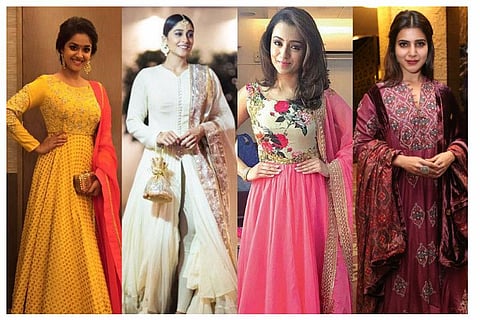

South Indians take great pride in their traditional clothes. Apart from the rare ‘designer’ saree worn at wedding receptions and the everyday salwar-kameez with dupatta, most clothing trends from the north find it hard to sustain in southern India.
Today, the humble salwar-kameez has been baptized to the south Indian cult and comes in beautiful Mangalgiris, Coimbatore and Kanchi cottons. Along the way came leggings and the kurta-leggings combination became the official ‘power-dressing’ attire among corporate employees.
When the north went through a Mughal revivalism complete with chandbalis, anarkalis, shararas and ghararas, designers did not expect the south to pick up these trends. However, the anarkali has somehow caught the imagination of South Indians and has established its roots in the region across a period of about five years now.
Vasudha, Founder and Editor, Southindiafashion.com, a leading fashion blog, recollects, “One could hardly spot anarkalis in the south during the early 2000s. Young girls preferred simple cotton, silk and georgette salwar-kameez suits. However, during the 2010s, anarkalis became a really popular trend and looks like they are here to stay. The best part is that, the anarkalis available in South India somehow manage to infuse the traditional designs, texture and prints of the south.”
Chennai based fashion blogger, Shilpa Ramachandran adds, “Anarkalis became a huge trend in the south when we started spotting actors sporting these clothes in films and award parties alike. It was also around the same time that actors started becoming careful of how they were seen in public and started working with stylists for their public appearances. By then, it was a well-established trend in the north. Designers had a plethora of designs to offer to these actors.”
Perhaps because the anarkali manages to look sensual while being "modest", the trend struck an instant chord with the south Indian audience.
Image courtesy: Dhvani Gandhi, Tantu Weaves.
Vijayalakshmi Krishna, Founder and Designer, Aavaranaa, says, “Five years ago, every bride would want at least one anarkali for her wedding trousseau. Daily wear kalidars became the norm and straight cuts were considered banal. Right now, anarkalis are not necessarily in but those with asymmetric cuts and high-low hemlines are.”
Image courtesy: A high-low anarkali by Aavaranaa.
Shilpa adds, “Anarkalis are still huge in the wedding scene with the friends and sisters of the bride favouring them for light evening events like mehendi, sangeet and reception. They are a hit because unlike a saree, you don't have to be conscious about the attire. They have definitely evolved as well. I treated myself to a high-low anarkali in which the back almost grazes the ground. We also see a lot of anarkalis fashioned like a full length gown!”
The ability to morph into multiple avatars has also been a crucial reason for the anarkali standing the test of time. Designers and patrons are avoiding the usual georgettes and chiffons today and going for daring fabrics.
Ahmedabad based Designer and Founder of Tantu Weaves, Dhvani Gandhi, says, “In the south, anarkalis definitely work well as there are so many different kinds of weaves one can find to play with. For instance, an Ikat anarkali is perfect to be worn at any time of the day. An unused Kanchipuram silk saree can be transformed into a versatile silk anarkali.”
Image courtesy: Rama in a Studio Rama design crafted from South Indian fabrics.
Hyderabad based designer and owner of Studio Rama, Rama Rrebbapragada works a lot with exclusive clients who come with varying requirements. She believes people now want custom-made designs that look unique.
At her studio in Banjara Hills, she observes a lot of clients asking for anarkalis crafted out of pure Kanchipuram and Gadwal silks, finished off with a brocade dupatta and heavy embroidery.
She says, “In my opinion, clients are now moving toward custom-made clothing tailored to flatter their body. While some prefer the traditional elaborate kalis, some others want a bias-cut anarkali tailored full length almost like a gown. There is a lot of fusion of western elements while retaining the quintessential Indian touch.”
It is possible to make a fashion statement while sporting something traditional. One can go the Indo-western route or choose to pair the anarkali with different accessories. One can even play around with fabrics and colours. Anarkalis flatter almost every body type and work for a variety of occasions.
Vasudha says it is never too late to jump into the bandwagon and embrace the trend. She also adds that even a very traditional attire like an anarkali can be bold and funky. She says, “If you are someone who is more into western style than desi clothing, go Indo-western."
Image courtesy: Shilpa of Frillthrills in an anarkali.
Shilpa’s advice is to choose an anarkali that has been tailored well while Dhvani says pairing them with jeans or palazzos would make for a unique look.
Image courtesy: Dhvani Gandhi, Tantu Weaves.
Wearing them as dresses are also a great way to incorporate them in your everyday wardrobe, says Vijayalakshmi. She adds, "Expecting moms and new mothers also prefer anarkalis since they can be comfortable and fashionable. In fact, it is one piece of clothing one can wear well into the pregnancy and after."
Sticking to monotones and flattering cuts is a great option for those who are conscious about their waistline, says Rama. She goes on to add, “Today one can do a variety of cuts. Play around with fabrics and colours to make it more appealing.”
From being categorised as a special occasion wear, they have now become mainstream and casual. Wear them dressy, wear them casual. Either way, anarkalis are here to stay.